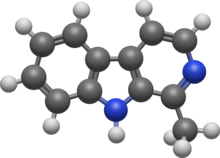Harmane
Topic: Chemistry
 From HandWiki - Reading time: 4 min
From HandWiki - Reading time: 4 min

| |

| |
| Names | |
|---|---|
| Preferred IUPAC name
1-Methyl-9H-pyrido[3,4-b]indole | |
| Other names
Harman, Aribine, Aribin, Locuturine, Locuturin, Loturine, Passiflorin, 1-Methylnorharman, NSC 54439
| |
| Identifiers | |
3D model (JSmol)
|
|
| ChEBI | |
| ChemSpider | |
| EC Number |
|
| KEGG | |
PubChem CID
|
|
| UNII | |
| |
| |
| Properties | |
| C12H10N2 | |
| Molar mass | 182.226 g·mol−1 |
| Melting point | 235–238 °C (455–460 °F; 508–511 K) |
| Soluble to 10 mM in 1 eq. HCl
methanol: soluble 50 mg/ml | |
Except where otherwise noted, data are given for materials in their standard state (at 25 °C [77 °F], 100 kPa). | |
| Infobox references | |
Harmane (harman) is a heterocyclic amine found in a variety of foods including coffee,[1] sauces,[2] and cooked meat.[3] It is also present in tobacco smoke.[4]
Harmane is related to other alkaloids, harmine and harmaline, found in 1837 in the plant Peganum harmala.[5] The name derives from the Arabic word for the plant, حَرْمَل (ḥarmal).
Harmane has been found to inhibit the early stages of the growth of the malaria parasite in the gut of mosquitoes infected by the bacterium Delftia tsuruhatensis, and can be absorbed by the mosquitoes upon contact.[6][7][8]
Chemistry
Harmane is a methylated derivative of β-carboline with the molecular formula C12H10N2.
Sources
| Family | Plant |
|---|---|
| Rubiaceae | Coffea arabica[1] |
| Solanaceae | Nicotiana tabacum[9] |
| Theaceae | Camellia sinensis[10] |
In 1962, Poindexter et al. found that there was very little harmane in tobacco, but a significant amount in tobacco smoke. They showed that it is produced from tryptophan by the heat of burning the tobacco.[9]
See also
References
- ↑ 1.0 1.1 Herraiz, T; Chaparro, C (2006). "Human monoamine oxidase enzyme inhibition by coffee and beta-carbolines norharman and harman isolated from coffee". Life Sciences 78 (8): 795–802. doi:10.1016/j.lfs.2005.05.074. PMID 16139309.
- ↑ Herraiz, T. (2004). "Relative exposure toβ-carbolines norharman and harman from foods and tobacco smoke". Food Additives and Contaminants 21 (11): 1041–50. doi:10.1080/02652030400019844. PMID 15764332.
- ↑ Louis, E. D.; Zheng, W; Jiang, W; Bogen, K. T.; Keating, G. A. (2007). "Quantification of the neurotoxic beta-carboline harmane in barbecued/grilled meat samples and correlation with level of doneness". Journal of Toxicology and Environmental Health, Part A 70 (12): 1014–9. doi:10.1080/15287390601172015. PMID 17497412.
- ↑ Herraiz, Tomas; Chaparro, Carolina (2005). "Human monoamine oxidase is inhibited by tobacco smoke: β-carboline alkaloids act as potent and reversible inhibitors". Biochemical and Biophysical Research Communications 326 (2): 378–86. doi:10.1016/j.bbrc.2004.11.033. PMID 15582589.
- ↑ Claude Lotfi (1967). "Contribution à l'étude du Peganum harmala (L.) (Hermel)". http://chimie.these.free.fr/CHIMTHE%20056.htm.
- ↑ Huang, Wei; Rodrigues, Janneth; Bilgo, Etienne; Tormo, José R.; Challenger, Joseph D.; De Cozar-Gallardo, Cristina; Pérez-Victoria, Ignacio; Reyes, Fernando et al. (2023-08-04). "Delftia tsuruhatensis TC1 symbiont suppresses malaria transmission by anopheline mosquitoes" (in en). Science 381 (6657): 533–540. doi:10.1126/science.adf8141. ISSN 0036-8075. PMID 37535741. https://www.science.org/doi/10.1126/science.adf8141.
- ↑ Offord, Catherine (3 August 2023). "Microbe stops mosquitoes from harboring malaria parasite". Science. https://www.science.org/content/article/microbe-stops-mosquitoes-harboring-malaria-parasite.
- ↑ Naomi Grimley (Aug 4, 2023). "Chance discovery helps fight against malaria". BBC. https://www.bbc.com/news/health-66394117.
- ↑ 9.0 9.1 Poindexter, E.H.; Carpenter, R.D. (1962). "The isolation of harmane and norharmane from tobacco and cigarette smoke". Phytochemistry 1 (3): 215–221. doi:10.1016/s0031-9422(00)82825-3. ISSN 0031-9422.
- ↑ Jiao, Ye; Yan, Yan; He, Zhiyong; Gao, Daming; Qin, Fang; Lu, Mei; Xie, Mingyong; Chen, Jie et al. (2018-06-20). "Inhibitory effects of catechins on β-carbolines in tea leaves and chemical model systems". Food & Function 9 (6): 3126–3133. doi:10.1039/c7fo02053h. ISSN 2042-650X. PMID 29789822. https://pubmed.ncbi.nlm.nih.gov/29789822.
 |
 KSF
KSF